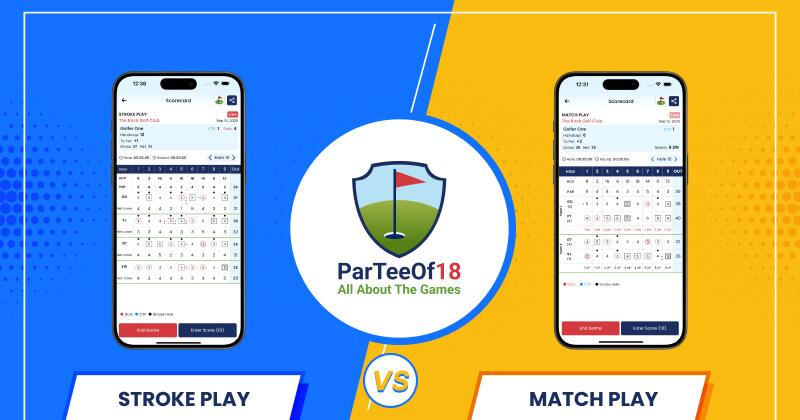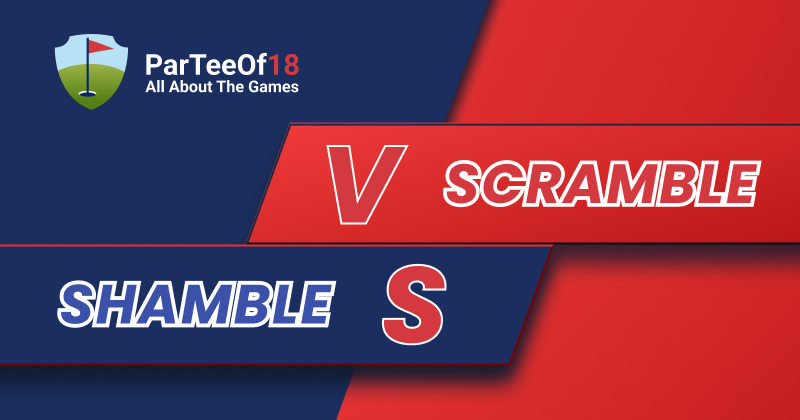In golf, two popular formats are “best ball” and “scramble,” which frequently confuse people. In the best ball format, each player plays their own ball throughout the round, and the best individual score counts as the team’s score. This format is ideal for players who want to showcase their individual skills while also contributing to the team. Scramble, on the other hand, focuses on teamwork and strategy—everyone hits, but the team takes each shot from the best hit position available, resulting in a faster pace of play and a social aspect. Both formats are popular for charitable tournaments, corporate events, and casual rounds, with options for players of all skill levels and preferences. Knowing the differences between Best Ball vs Scramble allows golfers to choose a play style that works best for their group, which can be difficult when competing with their own golf experience in Best Ball or their preference for the feel and pace of Scramble.
We will go over the definitions, history, pros and cons, and tips for selecting the best format for your golf goals this year. Irrespective of your ability to play golf, understanding when to play Best Ball or Scramble makes the game more enjoyable.
What Is Best Ball in Golf?
Best Ball is a format where each golfer plays their own ball throughout the round. After everyone completes a hole, the team records the lowest score among the group.
Example: If four golfers on a team score 4, 5, 6, and 7, the team records a 4 for that hole.
This system rewards consistency but also allows weaker players to contribute without pressure. A single strong player can carry the team, but every golfer still plays their full round. That makes Best Ball vs Scramble distinct, since Scramble relies heavily on teamwork at every shot.
Best Ball is often used in competitive settings, including club tournaments and charity outings. It works well for groups of mixed skill levels because everyone still participates fully.
What Is Scramble in Golf?
Scramble is one of the most social and enjoyable formats in golf. In this game, every player tees off, and the team decides which shot is best. All players then play their next shots from that location. This continues until the ball is holed.
Example: On a par 4, one player drives the ball straight down the fairway. The group chooses that ball as the best, and everyone plays their second shot from that spot.
Scramble encourages teamwork, speeds up play, and reduces pressure on less experienced players. Unlike Best Ball, not everyone’s individual score matters. Instead, it’s about contributing at the right moment. That’s why golfers often compare Scramble vs Best Ball when choosing a format for a casual weekend or corporate outing.
History of Best Ball and Scramble Formats
Golf’s traditional format is stroke play, where every player records every stroke and tallies them at the end. But as the sport grew in popularity, alternate formats emerged to make it more inclusive and enjoyable.
- Best Ball dates back to competitive team events in the late 19th century. It was created to balance individual play with team dynamics. Today, it’s widely used in amateur and professional tournaments.
- Scramble evolved later, primarily in North America, to speed up casual rounds and make the game more approachable. It became especially popular in charity events where golfers of all skill levels come together.
The growth of these team styles shows why golf best ball vs scramble remains a common discussion in clubhouses around the world.
Best Ball vs Scramble: Key Differences
While both formats are team-based, their structure sets them apart. Here’s a quick side-by-side look:
| Feature | Best Ball | Scramble |
| Play Style | Each golfer plays their own ball | The team plays from the best shot each time |
| Scoring | The lowest individual score counts per hole | Team score from the collective best shots |
| Pace of Play | Slower, everyone plays the full hole | Faster, fewer shots overall |
| Pressure | Individual performance matters | Shared responsibility |
| Best Suited For | Competitive and skilled players | Mixed-skill groups, beginners, charity events |
This chart highlights why Scramble golf vs Best Ball can feel like comparing two completely different games, even though both belong to the same sport.
Pros & Cons: Best Ball Format and Scramble Format
Both Best Ball and Scramble have their own advantages and drawbacks depending on the type of golf experience you want. Best Ball focuses on individual consistency, while Scramble emphasizes teamwork and fun. Below, we explore the major pros and cons of each format in detail so you can choose the one that suits your game or event.
Pros of Best Ball
Every Golfer Plays Their Own Round
In Best Ball, each golfer plays their ball from the tee until it’s holed, giving them a complete experience of the course. This means even if your score doesn’t count for the team, you still get the satisfaction of playing all 18 holes. For golfers looking to practice, improve, and challenge themselves while also participating in a team game, Best Ball is a perfect choice
Rewards Consistent Players
The format is built to reward steady performers. A golfer who consistently shoots bogey or par scores will often carry the team, even if they don’t hit the longest drives or flashiest shots. Best Ball celebrates consistency and reliability, making it ideal for players who may not be flashy but rarely make big mistakes. Every steady shot counts toward the team’s success.
Great for Tournaments and Leagues
Best Ball is widely used in competitive settings because it balances fairness and individual accountability. Since everyone plays their own shots, the results reflect true golfing ability. It’s common in club leagues, corporate tournaments, and charity events where organizers want to combine individual skill with a team element. This makes it a respected and versatile choice for more serious rounds.
Cons of Best Ball
Slower Pace of Play
Because each golfer plays their own ball through all 18 holes, rounds tend to take longer compared to Scramble. In groups of mixed abilities, this can cause delays, especially when higher-handicap players take more strokes. For golfers who value a quick, social round, Best Ball can sometimes feel drawn out.
Pressure on Beginners
Inexperienced golfers may feel added pressure if their scores rarely contribute to the team’s total. While everyone still plays every shot, weaker players can feel like passengers, which might affect confidence. The format tends to highlight differences in skill levels more than Scramble, making it slightly less inclusive for complete beginners.
Less Social Interaction
Since every player focuses on their own ball, there’s less teamwork and interaction during the round. Golfers often scatter across the fairway to play their individual shots, which can reduce the shared group atmosphere. While there’s still camaraderie, it doesn’t match the lively, collective decision-making found in Scramble.
Pros of Scramble
Fast and Efficient Play
Scramble is designed for speed. Because the team always plays from the best shot, weaker shots are ignored, and fewer strokes are required to finish each hole. This makes it perfect for charity events or large tournaments where dozens of groups are on the course. Players can move quickly without sacrificing enjoyment, and the overall pace of play is significantly faster than Best Ball.
Encourages Teamwork
The Scramble format thrives on collaboration. Every decision—whether it’s choosing the best drive or deciding who should putt first—is made as a group. This creates a fun, engaging atmosphere where players cheer for one another and celebrate good shots together. Even golfers who only contribute occasionally feel included, making Scramble a favorite format for corporate outings and casual weekends.
Beginner-Friendly Format
One of the best things about Scramble is its inclusivity. Beginners can relax knowing their less-than-perfect shots won’t hurt the team. They still get to swing, contribute, and enjoy the game without feeling judged. If they hit one great shot, it might end up being the team’s best, giving them a real sense of accomplishment. Scramble helps level the playing field for mixed-skill groups.
Cons of Scramble
Individual Skills Can Be Overlooked
Since Scramble relies on collective performance, steady players don’t always get recognized for their consistency. A weaker player might hit one lucky shot that determines the team’s result, while the more skilled player’s steady efforts get overshadowed. This makes it harder to measure individual improvement or track true progress.
Less Competitive Depth
Scramble is fantastic for fun, but it’s not as competitive as Best Ball. Because bad shots are ignored and only the best shots count, the format doesn’t accurately reflect individual abilities. For golfers seeking a serious challenge or a way to prepare for tournaments, Scramble may not provide enough competitive depth.
Uneven Contribution Feelings
While Scramble encourages inclusivity, it can sometimes make weaker players feel left out if their shots are rarely chosen. Conversely, stronger players might feel like they’re carrying the team. This imbalance can occasionally dampen the enjoyment for some golfers, though good group dynamics usually keep the experience positive.
Which Format Should You Play?
Choosing between Best Ball and Scramble depends on your goals, skill levels, and the type of outing you’re planning. Both formats are fun and rewarding, but they suit different situations. Here are some key scenarios to help you decide which one is the best fit for your next round.
Play Best Ball if You Want Competition
Best Ball emphasizes individual consistency, making it perfect for golfers who enjoy testing their skills while still working in a team setting. It’s a great choice for tournaments, leagues, or competitive outings where players want accurate results that reflect their performance. Every stroke counts, so steady golfers thrive in this format.
Play Scramble if You Want a Social, Fun Round
Scramble prioritizes teamwork and inclusivity, making it the go-to choice for charity outings, corporate events, or casual weekends with friends. By always playing from the best shot, weaker players feel included, and stronger players keep the pace fast. It’s a relaxed, enjoyable way to ensure everyone has fun without pressure.
Choose Scramble if You’re a Beginner
For new golfers, Scramble is often less intimidating. Even if your shots aren’t the best, your contribution still matters occasionally, and you won’t hold the team back. This format builds confidence, keeps the game lighthearted, and allows beginners to enjoy the social side of golf without worrying about every stroke.
Pick Best Ball for a True Test of Skill
If you’re serious about measuring your progress or preparing for competitive play, Best Ball is the better option. It allows every player to complete their own round while still benefiting from a team element. This balance of individual accountability and group scoring makes it ideal for golfers who want to sharpen their performance.
How to Keep Score Without Confusion
Scoring in golf can already be tricky, and formats like Best Ball or Scramble add more complexity. Paper scorecards often lead to mistakes or disputes. To avoid confusion and keep the game enjoyable, here are a few effective ways to manage scoring more smoothly.
Traditional Scorecards
The classic way is to record scores on a paper scorecard. While simple and inexpensive, it can quickly become messy in team formats. Mistakes happen when tracking multiple players or deciding whose score counts, and rain or wind can damage the card. It works but requires focus and accuracy.
Dedicated Golf Apps
Golf apps designed for scoring make things easier by automatically calculating results. With just a few taps, they handle formats like Best Ball and Scramble without the risk of manual errors. They also save past rounds, provide insights, and allow you to focus on the game instead of math.
Assigning a Team Scorer
In casual rounds, one player can serve as the official scorer for the group. This reduces confusion, as only one person is responsible for updating the scores. However, it still relies on manual accuracy and can put pressure on the scorer if the format is complex or the group is large.
Conclusion
Golf thrives on variety, and Best Ball vs Scramble proves how different formats can shape the experience. It emphasizes consistency and competition, while Scramble prioritizes speed, teamwork, and fun.
The debate over scramble golf vs best ball will continue, but the truth is, both formats have their place. If you want to test your skill, choose Best Ball. If you want laughter, speed, and teamwork, choose Scramble.
And whichever you play, make sure you’re scoring with ease. Instead of struggling with paper scorecards, try a golf scoring app like ParTeeOf18. ensuring your group focuses on the game, not the math.
FAQs
1. What is the main difference between Best Ball and Scramble?
In Best Ball, every player plays their own ball on each hole, and the lowest score among the group counts. In Scramble, the team always plays from the best shot, and everyone hits from that spot until the hole is finished. Best Ball emphasizes individual consistency, while Scramble focuses on teamwork and speed.
2. Which format is better for beginners: Best Ball or Scramble?
Scramble is generally better for beginners. Since the team always plays from the best shot, weaker players don’t feel pressured if their shots aren’t perfect. This format is inclusive, fun, and less stressful. Best Ball can be challenging for new golfers because every stroke counts, though it helps improve consistency.
3. Can Best Ball and Scramble be used in tournaments?
Yes, both formats are used in tournaments, but for different reasons. Best Ball is popular in leagues and competitive events because it rewards consistent play and individual accountability. Scramble is commonly used in charity events and corporate outings because it’s beginner-friendly, faster, and more social.
4. How can I keep score easily in Best Ball or Scramble?
While you can use paper scorecards, they can get confusing, especially in team formats. Golf scoring apps simplify the process by automatically applying the rules, calculating team scores, and sharing results instantly. This ensures accuracy and keeps the focus on fun instead of math.



